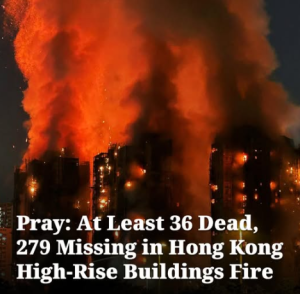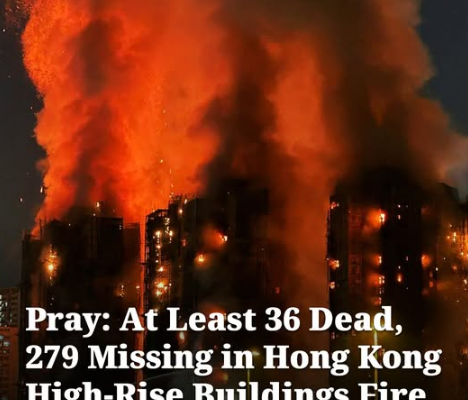🔥 What happened — the blaze at Wang Fuk Court
On Wednesday, 26 November 2025, a massive fire broke out at the Wang Fuk Court residential complex in Tai Po District. Wikipedia+2WSLS+2
-
The complex consists of eight high-rise apartment towers (roughly 30–32 storeys each), home to thousands of residents. The Guardian+2Wikipedia+2
-
The fire reportedly started at about 2:50–3:00 PM (local time). Wikipedia+2South China Morning Post+2
-
Flames ignited on the external scaffolding of one building — which was covered with bamboo scaffolding and protective green netting because the complex was undergoing renovations. Wikipedia+2The Guardian+2
-
From there, the fire spread rapidly, engulfing not just that building but eventually seven out of the eight towers. Wikipedia+2https://www.kxii.com+2
-
Authorities described the blaze as unusually fast-moving. The fire alarm was escalated quickly from a low-level alarm to a level 5 alarm, the highest emergency level — the first such classification in Hong Kong in years. South China Morning Post+2ABC+2
By the time rescue crews started to bring the fire under partial control, thick smoke, intense heat, and structural hazards — including collapsing scaffold and debris — dramatically hindered operations. The Guardian+2CBS News+2
Human toll — casualties, missing, and destruction
As of the latest official reports:
-
44 people are confirmed dead, including at least one firefighter who died during rescue operations. South China Morning Post+2CBS News+2
-
279 people remain missing, unaccounted for after the blaze. South China Morning Post+2https://www.kxii.com+2
-
Dozens more are injured — many hospitalized with serious burns or smoke inhalation. At least 45 are in critical condition. South China Morning Post+2CBS News+2
-
In total, nearly 900 people were evacuated and are now staying in temporary shelters set up by local authorities. South China Morning Post+2The Guardian+2
For many residents, the fire destroyed their homes, possessions, and sense of security. As one distraught resident told reporters: “We bought in this building more than 20 years ago. All of our belongings were in this building, and now that it has all burned like this, what’s left?” The Guardian
Beyond the human cost, the damage to the buildings appears extensive. The affected towers are engulfed, and multiple units across floors — especially upper floors — remain inaccessible, trapping people inside. South China Morning Post+2The Guardian+2
Given the scale, this blaze is now considered the deadliest residential fire in Hong Kong in decades. Wikipedia+2Al Jazeera+2
Why the fire was so devastating — alleged negligence, unsafe materials, and rapid spread
Investigators believe several factors combined to turn a fire into a catastrophic inferno:
-
Renovation in progress: The complex was undergoing maintenance and renovation work since July 2024. The buildings were covered in bamboo scaffolding and protective green mesh netting to facilitate the repair work. South China Morning Post+2The Guardian+2
-
Flammable, non-compliant materials: Police say they discovered highly flammable materials, including polystyrene/foam boards — used to seal windows and for construction — which may have violated fire-safety standards. Yahoo+2https://www.cleveland19.com+2
-
External scaffolding as ignition path: Flames are believed to have started on scaffolding (outside the building) and then penetrated into the buildings, enabling the fire to spread floor-to-floor and tower-to-tower. The Guardian+2CBS News+2
-
Environmental conditions: Windy weather may have worsened the blaze, helping the fire spread faster and complicating firefighting efforts. ABC+2Al Jazeera+2
-
High density and tightly packed structure: The towers are high-rise and densely occupied, which likely increased the number of victims and complicated evacuation and rescue. The Guardian+2CBS News+2
In short: what may have started as a manageable fire turned into a devastating tragedy — because of a combination of unsafe materials, ongoing renovation, dangerous scaffolding, and structural vulnerability.
Accountability — arrests and criminal investigation
In the early hours after the fire, local police made arrests — a rare and serious escalation indicating suspicion of criminal negligence:
-
Three men have been arrested on suspicion of manslaughter. Wikipedia+2https://www.kxii.com+2
-
According to police, the three are two directors of the construction company responsible for renovations and one engineering consultant. The Guardian+2Yahoo+2
-
A senior police official said there was “reason to believe” that the company’s conduct was “grossly negligent,” especially because of the use of non-compliant, flammable materials and scaffolding netting. Yahoo+2South China Morning Post+2
Authorities have launched a full-scale investigation, which may include building-safety code compliance reviews, criminal liability for negligence, and checks on renovation permits and oversight. South China Morning Post+2ABC+2
The arrests mark a notably strong response — underscoring how seriously officials view this disaster and signaling potential accountability for those responsible for construction practices.
Aftermath — rescue efforts, emergency response, and social impact
As of the latest update:
-
Firefighters and rescue crews remain on site. Some of the blaze has been contained: four of the seven affected towers are now reportedly under control. South China Morning Post+2The Guardian+2
-
Rescue operations continue, especially in parts of the complex where extreme heat, smoke, and structural instability still pose major hazards. The Guardian+2WSLS+2
-
Nearly 900 residents have been evacuated to temporary shelters; local authorities say they are providing support — but many remain displaced, unsure about when or if they can return, or have lost everything. South China Morning Post+2The Guardian+2
-
Public outrage and grief are intense. Many residents and observers are demanding accountability, thorough investigation into construction practices, and stricter enforcement of fire safety regulations. The Guardian+2The Guardian+2
-
Political and social ripple effects: the disaster comes just ahead of local elections (scheduled for December 7), prompting authorities to suspend campaigning out of respect — and raising broader concern about housing safety practices in Hong Kong. South China Morning Post+2The Guardian+2
The scale of destruction, loss of life, and potential negligence exposed by this fire has shaken public trust and triggered urgent calls for reform.
Wider significance — safety regulations, urban living risks, and what this tragedy reveals
This fire is not just a horrific accident — it also raises urgent questions about building safety, renovation standards, and urban living conditions in densely populated cities such as Hong Kong. Some of the key broader implications:
-
Construction and renovation safety must be taken seriously: The presence of flammable materials (foam, plastic netting), compromised scaffolding, and inadequate fire-resistant insulation highlight systemic risk when safety regulations are ignored or circumvented.
-
Enforcement and oversight matter: It is not enough to have codes — without vigilant enforcement and accountability, disasters like this become possible. The arrests suggest possible negligence, but systemic reforms may be needed to prevent recurrence.
-
Vulnerability of high-density housing: High-rise residential towers — especially with older construction or undergoing renovation — are especially vulnerable when fire hazards arise. Evacuations, rescue efforts, and disaster responses become vastly more complex.
-
Social cost beyond property damage: Such tragedies disrupt lives, destroy homes, scatter communities, and inflict deep psychological trauma. For many residents, the fire represents not just loss of physical space but loss of history, memories, security, and community.
-
Urban policy implications: This may prompt authorities and developers to re-evaluate renovation practices, scaffolding standards (bamboo + mesh), external insulation use, evacuation protocols, and emergency readiness — especially in older towers or tightly packed estates.
In short, the fire is a stark reminder: in cities where space is tight and living vertically is commonplace — safety regulations, oversight, and enforcement can literally mean the difference between life and death.
What’s next — investigation, accountability, and recovery
Looking ahead, some key issues to watch:
-
Ongoing investigation and legal proceedings. The three arrested men may face criminal charges if evidence confirms gross negligence. The broader investigation may also examine company practices, building regulations compliance, and permit processes.
-
Support for victims and displaced residents. Many families have lost loved ones; many more have lost their homes. Government provision of shelter, compensation, mental health support, and long-term housing solutions will matter.
-
Policy and regulation reforms. This disaster may become a catalyst for stricter building-safety rules, rethinking of scaffolding/practice norms, better fire-resistant materials, and more rigorous oversight for renovations — especially in high-density residential estates.
-
Public scrutiny of developers, contractors, and renovation companies. Local authorities and citizens alike may demand transparency and accountability from renovation contractors, building owners, and regulatory agencies — to prevent recurrence.
-
Community healing and rebuilding. Beyond bricks and mortar, rebuilding trust, community cohesion, and sense of safety — especially among survivors and displaced families — will be a long and difficult process.
Conclusion — a tragedy, a warning, a turning point
The fire at Wang Fuk Court in Tai Po is a devastating event: at least 44 lives lost, hundreds missing, and a community torn apart. What started as a renovation — perhaps meant to improve living conditions — may have ended in tragedy due to alleged negligence and unsafe practices.
The arrests of three construction-company officials signal a serious attempt at accountability. But more is at stake. For Hong Kong — and for dense urban centers worldwide — this blaze underscores the critical importance of fire-safety regulation, construction oversight, and the protection of residents’ lives over costs or convenience.
In the coming days and weeks, as investigations progress and survivors cope with loss and displacement, the real test will be whether authorities use this tragedy not just to punish, but to prevent — to reform building codes, renovation standards, oversight mechanisms, and restore public trust.


